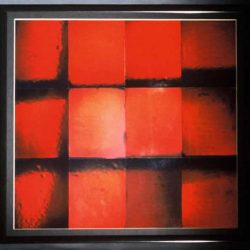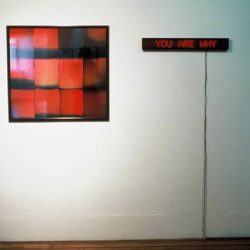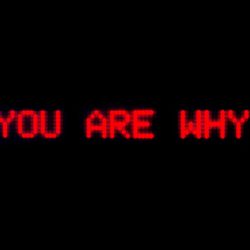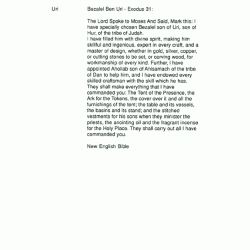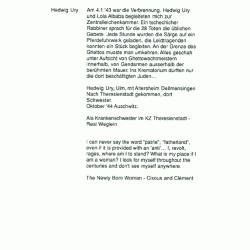LED display sign with holograms of texts, English and German, 1992
The 12, A4 holograms of texts have been framed together in steel frames, in three rows of four, 83cm x 78 cm
The LED displays a moving message with various combinations of the three words YOU ARE WHY. The dictum YOU ARE WHY, not only poses the most fundamental of existential questions but is also word-play — the phonetic spelling of the artist’s name URY, in English.
Accompanying the sign are twelve holographic pages of quotations, framed in rows of three by four. The format emulates the Urim and Thummim, an ancient Jewish oracle. Taking issue with the ‘Word’ of the bible and the name of the father, which have been upheld as Law from time immemorial, from Moses until Freud, Tanya Ury attempts to locate her own position within the Judeo/Christian tradition.
“The word racine (root) has taken on a somewhat vulgar tint nowadays, rubbed in ideologies that have racist connotations. We must reduce it to ashes and wait for its rebirth. Then we will hear a very beautiful word. I thank Jean Racine, I return to my racines with Racine. The signifiers of our great writers work on us; the common proper name, the proper common name affects us, as readers, and especially the one whose name it is. We must all deal with the unconscious effects of our proper name. We find this aspect of language’s intervention in our destiny on the flesh of our imagination. We work on writers whose names are bearers of textual effects. That doesn’t mean I am attracted by authors whose names are at work in the language but simply that there aren’t any names which don’t produce signifying effects. Genet constantly puts his name to work in the French language. Entire works were born from his name. There is corneille (crow) in Corneille’s texts: the bird, the relation to elevation, to flying, to a certain type of bird. If we take up Leviticus again, we will find all kinds of crows. Racine must translate the effects of roots (racine) in all his texts, especially the roots (racines); since the proper name belongs to the order of roots, it is the lightest and most intangible root we have. It roots us, in language and beyond, without our knowing precisely where. One author whose name was not without signifying effects – of which he was perfectly well aware – is Kafka. In German, Kafka means chouca = corneille (crow). He too is a bird. He knows it, plays with it, inscribes it. In Wedding Preparations in the Country and Other Posthumous Writings and in the Diaries there are several instances of this type of small aphorisms that work on crows1. It’s magnificent. The crows maintain that they can destroy the sky.
The crows maintain that a single crow could destroy the heavens. There is no doubt about that, but it proves nothing against the heavens, for heaven simply means: the impossibility of crows.2
It’s possible or it’s impossible, no one can go and verify. Perhaps that’s what going to the root is, going toward the unverifiable. As for Clarice Lispector’s name, who could invent a name more promising of light or vision?”3
P. 145 – 146, “Three Steps on the Ladder of Writing”, Hélène Cixous, 1993, Columbia University Press /New York, ISBN 0−231−07659−2
1 Franz Kafka, Wedding Preparations in the Country and Other Posthumous Prose Writings, tr. C, Kaiser and G. Wilkins (New York: Schocken); Diaries 1919 – 1923, tr. Martin Greenberg (London: Mandarin, 1992)
2 Franz Kafka, Wedding Preparations in the Country, p. 51
3 Clarice Lispector (December 10, 1920 – December 9, 1977) was a Brazilian writer. Acclaimed internationally for her innovative novels and short stories, she was also a journalist. en.wikipedia.org/wiki/…
***
Ury has also created other artworks that might be considered visual poetry. Moving Message 1992, incorporates an LED sign displaying the words: you are why; Sonata in Sea 1999 – 2000 is a photo series combined with poetry and wrestlewithyourangel 2001, is a neon sign produced together with the neon sign neonazi 2001; the title of a double photo portrait lesser is me more or less 2003 plays on the name of the German Post-Impressionist Lesser Ury, as does the title of a further double portrait or else 2007, which refers to the German writer Else Ury. The title of a third photo-portrait Beelzebularin 2005 (in the Promised Land series) reveals itself to be an anagram of the biblical Bezalel Ben Uri. half dimensional — semi detached 2010, combines the first of the half dimensional poems with the photograph semi detached.
concrete – a collection of works (including poetry series)
- femininity – femininiation 2011
- Moving Message 1992
- Word-fore-play – Recipe for Love 1995
- Sonata in Sea 1999 – 2000
- wish 2000
- wrestlewithyourangel 2001
- neonazi 2001
- Poker Poems 2003
- elle la poésie 2003
- lesser is me more or less 2003
- Promised Land – a collection of works 2005
- Mid Summer 2005
- Un 2006
- or else 2007
- half dimensional poems 2009 – 2011
- half dimensional – semi detached 2010
- cement 2011
- on a mat appear 2011 -
- Lost Poems 2011
- weißer neger (white nigger) 2011
- informed 1.3.2011
- concrete party 2011
- oral call 2011
- cross word 2011 – 2012
- toned poems 2011 – 2012
- two toned 2012
- pommes 2012
- taste of space 2012 – 2013
- leeres archiv (empty archive) 2013
- archive burn out 2011 – 2014
- hero of your own saga 2013 – 2014
- magical reality 2014 – 2015
Presentation
1992 – 93 Group exhibition, British Telecom New Contemporaries on tour, curated by Guy Brett, Derek Jarman & Marina Warner: Orion Newlyn, Cornerhouse Manchester, Angel Row Nottingham, Orpheus Belfast, ICA London (group) on tour during (GB)
1995 Logo image: YOU ARE WHY in New Feminist Criticism, Katy Deepwell, Manchester University Press (GB)
1999 Logo image: YOU ARE WHY in Aufbrüche — Migrantinnen, Schwarze Frauen und Jüdische Frauen im Kulturellen Diskurs Deutschland, Ulrike Helmer Verlag, Königstein 2000 (D)
2004 Logo image: YOU ARE WHY as frontispiece for Tanya Ury’s website
2007 (23.3.) On the online Feminist Art Base: www.brooklynmuseum.org Logo image: YOU ARE WHY, The Elizabeth A. Sackler Center for Feminist Art, The Brooklyn Museum, New York (USA)
Information
Quotations in the holographic texts of Moving Message are from:
The Collins English Dictionary
A Dictionary of World Mythology, Arthur Cotterell 1979, Guild Publishing, Book Club Associates, London (GB)
Geness 1, New English Bible
The Newly Born Woman, Cixous and Clément, Manchester University Press (in translation) 1986, ISBN 0 7190 1909 5
Selected Bibliography: Karl Schwartz. Lesser Ury, Berlin 1920 (Jewish Arts)
Als Krankenschwester im KZ Theresienstadt, Resi Weglein
The Jewish Almanac, ed.Richard Siegel and Carl Rhiens,
Bantam Books 1980, ISBN 0−553−01265−7
Moses and Monotheism, Sigmund Freud, The Newly Born Woman, Cixous and Clément,
Manchester University Press 1986, ISBN 0 7190 1909 5
